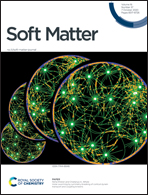Reinforced macromolecular micelle-crosslinked hyaluronate gels induced by water/DMSO binary solvent†
Abstract
Introducing macromolecular micelles into a biocompatible hyaluronic acid (HA) hydrogel is a promising strategy to improve its mechanical properties for biomedical applications. However, it is still unclear whether the solvent nature has an influence on the structure and property of HA gels especially when they are used for those cases containing binary solvents because reversible hydrophobic association within micelles could be weakened or even dissociated by organic solvents. In this work, we demonstrated that a binary solvent consisting of water and low-toxic dimethyl sulfoxide (DMSO), a commonly used cryoprotectant agent in biomedicine, can enhance the mechanical properties of hydrophobic-associated methacrylated hyaluronate (MeHA) gels crosslinked by diacrylated PEO99–PPO65–PEO99 (F127DA) macromolecular micelles, namely FH gels. The resulting FH hydro/organo-gels showed a crystalline structure due to polymer/solvent interactions. The FH gels showed a low swelling degree and the maximum strength (10.12 MPa), modulus (106.8 kPa) and toughness (1540 J m−2) in DMSO with a volume fraction of around 0.6. Moreover, the FH gels displayed a rapid recoverability under cyclic loading–unloading stress particularly in the presence of DMSO within the network due to their dual-dynamic dissipation networks. Such novel hydrophobic associated polysaccharide gels with tunable mechanical properties in binary solvents would be attractive in a cryopreservation system for cell-based applications.



 Please wait while we load your content...
Please wait while we load your content...